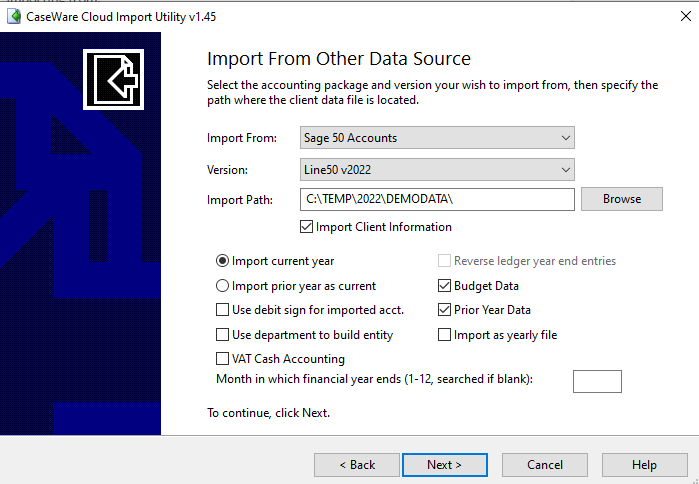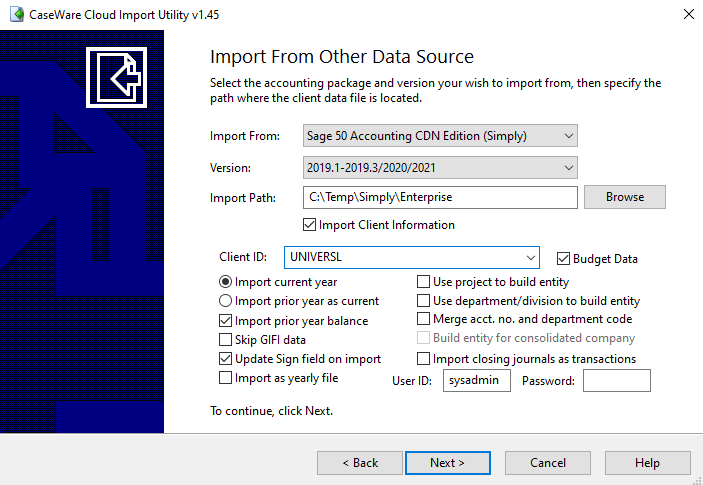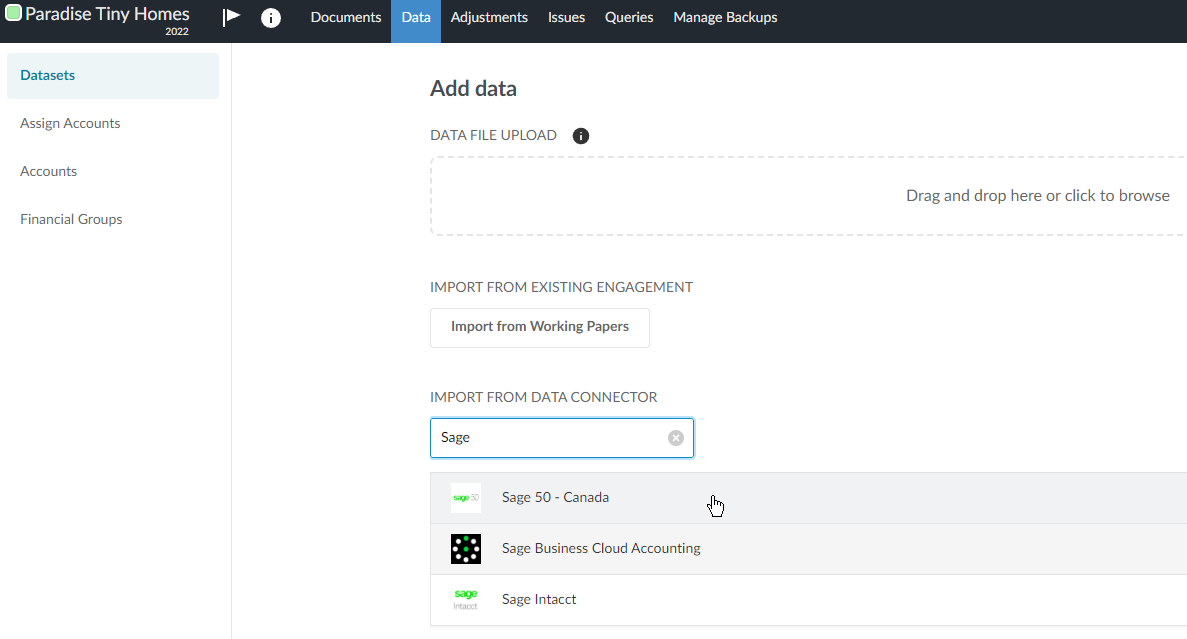Import aus Sage Desktop
You can import data from Sage by generating a zip file using the Caseware Cloud Import Utility, then importing it into your engagement. We currently support the following Sage accounting software:
-
Import from Sage 50 Accounts (Sage-Line50)
-
Import from Sage 50 Accounting CDN Edition (Simply)
For a list of versions we support, see Supported third-party accounting packages.
Note: Accounts with zero balances do not automatically import into Caseware Cloud apps with the exception of IDEA. To include zero-balance accounts, you must manually add and assign them to the appropriate financial groups.
Generate the import file for Sage 50 Accounts (Sage-Line50)
Before you start, make sure that you have the necessary import files:
-
Profile Information: ACCDATA\ACCOUNT.DTA
-
Chart of Accounts: ACCDATA\NOMINAL.DTA
-
CoA Index: ACCDATA\NOMINDEX.DTA
-
GL Detail: ACCDATA\SPLITS.DTA
-
Company Information: ACCDATA\SETUP.DTA
-
Account Types: ACCDATA\COA
-
Bank Information: ACCDATA\BANK.DTA
-
Ledger Index: ACCDATA\HEADER.DTA
-
Department Information: DEPARTM.DTA
To generate the import file for Sage 50 Accounts (Sage-Line50):
-
Download the Caseware Cloud Import Utility.
-
Open the Utility, select Other Data Source and select Next.
-
In the Import From and Version drop-downs, select Sage 50 Accounts and the version you're importing from.
-
In Import Path, select Browse and navigate to the folder that contains the ACCDATA folder, where the .DTA files you want to import are located.

-
Determine the remaining settings for the import.
The settings vary based on the version you previously selected.
-
Select Next, then Finish.
-
Save the generated zip file using the displayed prompt.
To continue the import process, see Import the data into your engagement.
Caseware Cloud Import Utility(.exe)
Generate the import file for Sage 50 Accounting CDN Edition (Simply)
Before you start, make sure that you install either Sage 50 Accounting (CDN Edition) or the Sage 50 Connection Manager utility from MyCaseware. You must have one of these applications to perform the import; however, do not install both.
To generate the import file for Sage 50 Accounting CDN Edition (Simply):
-
Download the Caseware Cloud Import Utility.
-
Open the Utility, select Other Data Source and select Next.
-
In the Import From and Version drop-downs, select Sage 50 Accounting CDN Edition (Simply) and the version you're importing from.
-
In Import Path, select Browse and navigate to the folder containing the client file you want to import. Client files for Sage have the .SAI file name extension.
The Client ID field automatically fills with the name of the client file.

-
Determine the remaining settings for the import.
The settings vary based on the version you previously selected.
-
Select Next, then Finish.
-
Save the generated zip file using the displayed prompt.
Caseware Cloud Import Utility(.exe)
Import the data into your engagement
After you generate the zip file using the Caseware Cloud Import Utility, you can import the data into your engagement.
To import the data into your engagement:
-
Open your Caseware Cloud engagement file. When you first open the engagement, the Engagement properties popup appears. Set Year end date to be the same as the data you are about to import.
The year-end date is the last element of the name of the zip file you generated in either Generate the import file for Sage 50 Accounts (Sage-Line50) or Generate the import file for Sage 50 Accounting CDN Edition (Simply). For example, for the file named UNIVERSAL CONSTRUCTION 2025-06-30.zip, the year-end date is June 30, 2025.
-
Gehen Sie auf die Seite Daten. The Data page opens to the Datasets tab.
-
If you’ve previously imported data, select Add data.
-
If your engagement is consolidated and has internal subsidiary entities, select which entity you want to import data for from the list.
-
Select Sage 50 - Canada from the list of data sources, then select Next.
If the option is not visible, you can use the Search box to find it.

-
At the Upload stage of the import wizard, select or drag-drop the zip file you generated using the Caseware Cloud Import Utility, then select Next.
-
At the Configure Data stage of the import wizard:
-
Reporting period is automatically filled with the reporting period of the data.
-
Year start Date is automatically filled with the start date of the data.
-
Year end Date is automatically filled with the end date of the data.
-
-
In Select dataset type, choose the type of dataset you are importing. Select Trial balance if you are importing a trial balance and General ledger if you are importing transactions.
-
If you selected Trial balance, collapse the list of dataset types by selecting the Collapse icon (
). Notice the Import the last 5 years of TB option appears. Select it to import up to five years of trial balance data if it is available in the zip file you generated.
-
Wählen Sie Weiter.
-
At the Confirmation stage of the import wizard, review the information and select Import.
To view the imported data, click View data next to the dataset you imported.
A new page appears displaying the data.
By default, all the columns in your dataset display. Click Columns to deselect those you want to hide.
Click Filters to filter the data displayed in the dataset.
For more information, refer to View the client's general and subledger data.
